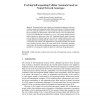Free Online Productivity Tools
i2Speak
i2Symbol
i2OCR
iTex2Img
iWeb2Print
iWeb2Shot
i2Type
iPdf2Split
iPdf2Merge
i2Bopomofo
i2Arabic
i2Style
i2Image
i2PDF
iLatex2Rtf
Sci2ools
157
click to vote
IWSOS
2011
Springer
2011
Springer
Evolving Self-organizing Cellular Automata Based on Neural Network Genotypes
Abstract This paper depicts and evaluates an evolutionary design process for generating a complex self-organizing multicellular system based on Cellular Automata (CA). We extend the model of CA with a neural network that controls the cell behavior according to its internal state. The model is used to evolve an Artificial Neural Network controlling the cell behavior in a way a previously defined reference pattern emerges by interaction of the cells. Generating simple regular structures such as flags can be learned relatively easy, but for complex patterns such as for example paintings or photographs the output is only a rough approximation of the overall mean color scheme. The application of a genotypical template for all cells in the automaton greatly reduces the search space for the evolutionary algorithm, which makes the presented morphogenetic approach a promising and innovative method for overcoming the complexity limits of evolutionary design approaches.
| Added | 15 Sep 2011 |
| Updated | 15 Sep 2011 |
| Type | Journal |
| Year | 2011 |
| Where | IWSOS |
| Authors | Wilfried Elmenreich, István Fehérvári |
Comments (0)

